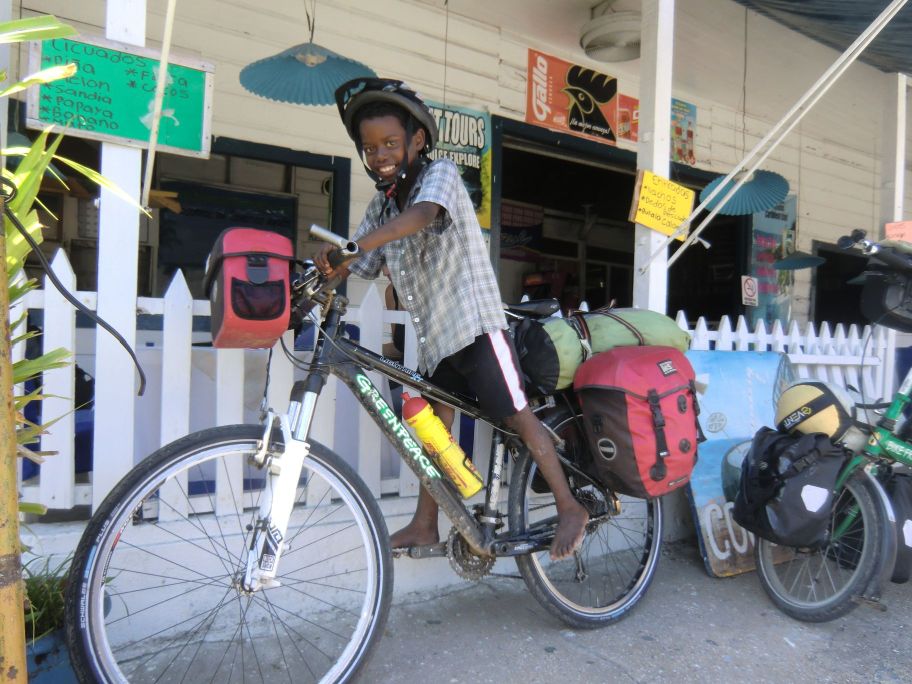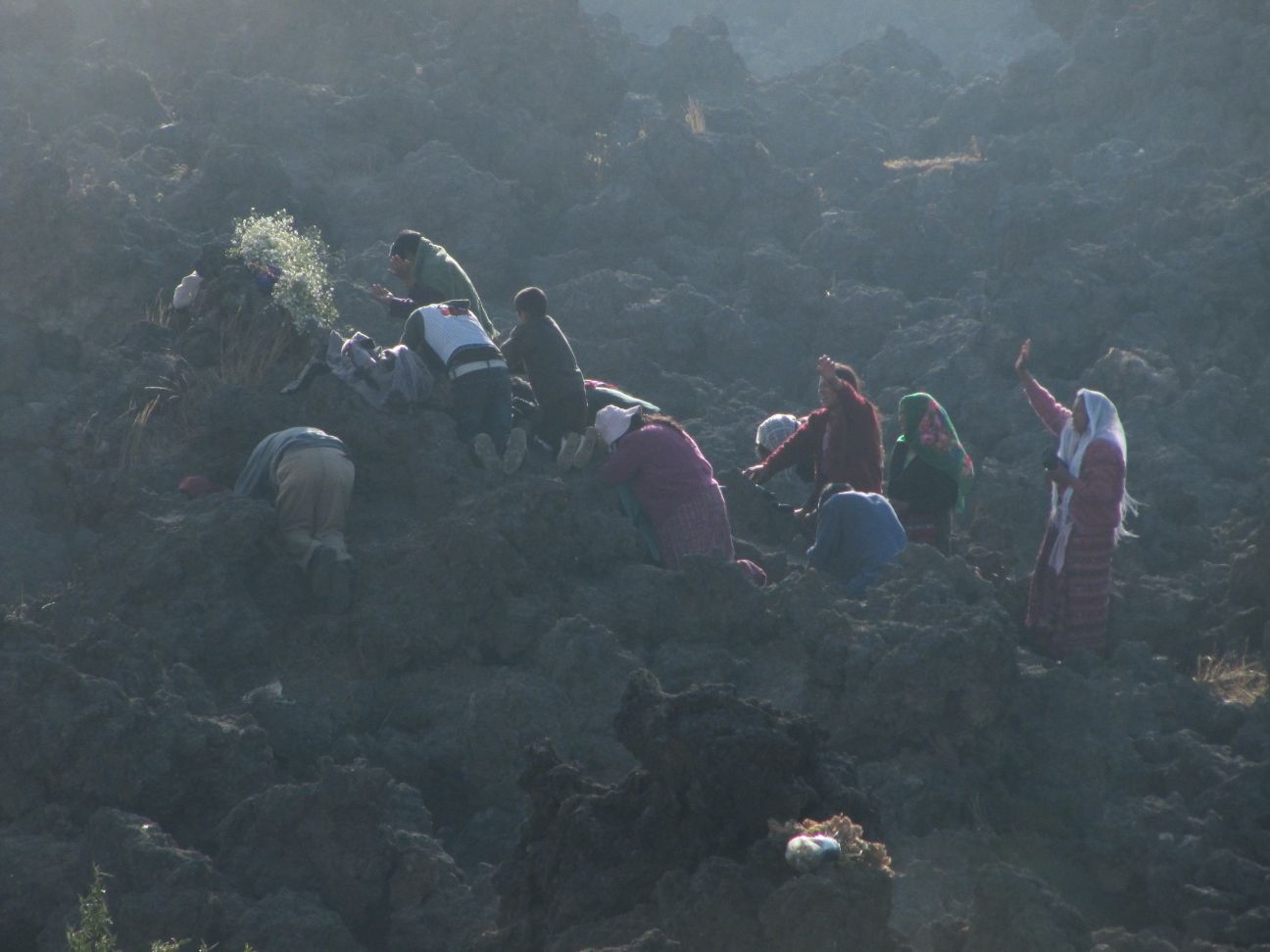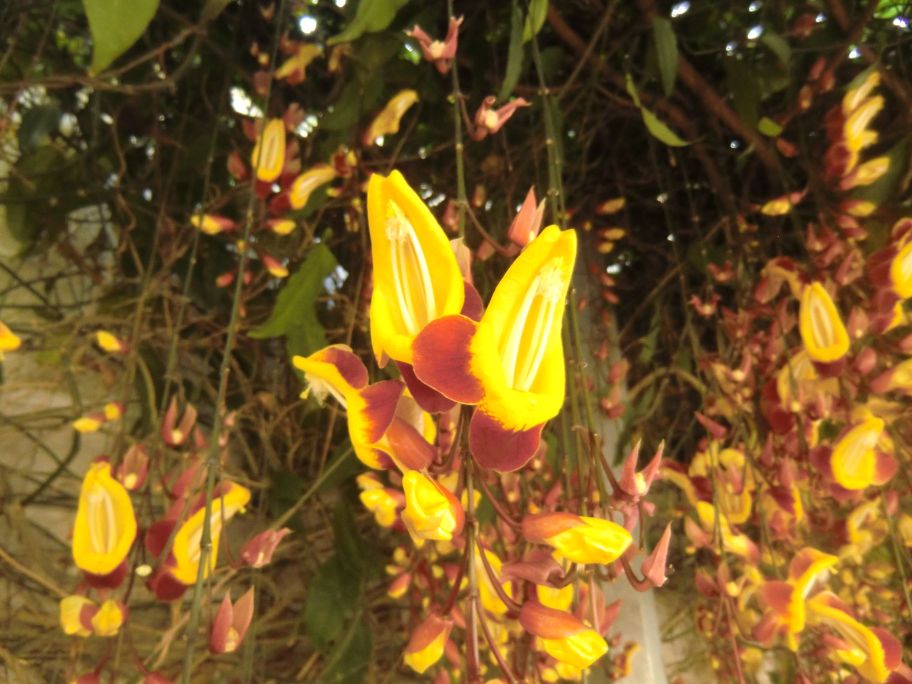 Kathrin and I spend a few days in tropical Rio Dulce. We visit the old Spanish Castle that used to protect the area from the pirates, and Agua Caliente, a small but hot(!) waterfall into a cool jungle creek 20 kilometers outside Rio Dulce. Holes in the yellow rocks on the waterfall smell like the door to hell - a really impressive scenario. On this day I break the 8000 kilometers mark. Never traveled so far on my bicycle! In the evenings we marvel upon the anchored sail boats on the lake and the possibility to sail ourself. Joey, an American rasta guy is actually selling his Yacht. Lots of beers and talking and hot heads at night.
Kathrin and I spend a few days in tropical Rio Dulce. We visit the old Spanish Castle that used to protect the area from the pirates, and Agua Caliente, a small but hot(!) waterfall into a cool jungle creek 20 kilometers outside Rio Dulce. Holes in the yellow rocks on the waterfall smell like the door to hell - a really impressive scenario. On this day I break the 8000 kilometers mark. Never traveled so far on my bicycle! In the evenings we marvel upon the anchored sail boats on the lake and the possibility to sail ourself. Joey, an American rasta guy is actually selling his Yacht. Lots of beers and talking and hot heads at night.
We rest our bicycles at the hotel and hitchhike on a side route to lake Atitlan where Urs, Werner and Jean are waiting for us. What a change of pace! It feels funny to carry our sea bags on our heads or shoulders rather then having them on the carrier of our bikes. In El Estor we get a ride on a Cardamom truck. A minute later a group of 7 young chaotic Americans dressed entirely in rags joins us on the truck bed. What a great smell! There is no pavement on the road anymore, and we eat a lot of dust during the bumpy ride. Just before La Tinta we (respectively Kathrin who speak proper Spanish) haggle for a reasonable fare with the armed co-driver of the truck. La Tinta is little appealing to us, and it is geting late. Therefore the two of us take a Collectivo for the remaining 30 something kilometers on a unpaved and bumpy road to Tactic near Coban. It is a long ride up the steep hills, ascending some 1500 meters...
On the following day we get a lot of rides with police cars, farmers, collectivos and merchants through a very hilly country on really lonesome and rough roads. For the last stretch to Santa Cruz del Quiche we take another Collectivo and once again congratulate ourselfes for hitchhiking rather than cycling. How many steep mountain passes did we cross today?
{youtube}FFEVNQXAnO0{/youtube}
One more day to Lake Atitlan. We take roaring ride in a cramped bus up and down some steep narrow valleys on roads apparently not made for ordinary cars. According to noise level and fierce acceleration of the bus, it must be powered by giant WWII bomber engines or similar. In Solola we marvel upon the colorful traditional dresses of man and women. They wear thick wollen blankets and kind of pillows above their neatly embroidered trousers around their waists. Pillows for man, that's fun for me who's somewhat used to the look of pillows in the back of Japanese women. In Solala we catch a first glimpse of the lake and the volcanos behind. Panajachel is a touristy town some 500 metres below Solola, from where boats go to San Pedro la Laguna on the other side of the lake. We wait for half an hour for more passengers before the boat sets out to a pretty scenic 40 minute ride over the wavy lake. The spirit of San Pedro welcomes us with a nice view over the colorful lakeside hotels and restaurants, and the village itself with the big white church building on the hill. Behind that, the San Pedro Volcano is towering, and further behind the Atitlan Vulacano. San Pedro is somewhat touristy along the lakeside, yet feels authentical further up the hill arround the market, where tiny old cottages neighbor new two or three storey houses. Progress everywhere. We meet our friends again and spend a few days recovering from the bumpy dusty roads that led us here. It is comfortably warm during the day, good for swimming and kajaking, and refreshingly cool at night. Not much mosquitos, what a blessing! San Pedro is known not only for hiking and kajaking and coffee but as well for affordable Spanish classes. After some investigations Kathin and I agree to have found a nice place to hang out for a few weeks soon.
But first we join our friends on another bus ride to Xena. The grey and brown and green highlands with the distant volcanos and the trucks thundering on the Panamericana give a very special scenery. Urs and Jean investigated about a climbing spot nearby the city. Werner finds us the oldest cab in town, a rusty yellow Japanese something. It takes a bumpy 20 minutes ride uphill and we find ourselfes in one of the most amazing places I've ever been to. In the steep gravel and lava fields of an  exploded volcano are small leveled areas where local man and women of all ages gather daily arround their preachers or healers and spend hours praying and singing and whining between the rocks. Each of them seems to carry a bunch of flowers that is left somewhere on the caldera. A fresh breeze that blows scraps of clouds over the lava field with the screaming prayers in their colorful clothes, the distant cones of two more volcanos and a dozen more details manifest a moon-like scenario. What a blessing to spend three days out here, climbing, reading, marveling, being... Then our time is up - Urs, Jean and Werner have to go back to Mexico.
exploded volcano are small leveled areas where local man and women of all ages gather daily arround their preachers or healers and spend hours praying and singing and whining between the rocks. Each of them seems to carry a bunch of flowers that is left somewhere on the caldera. A fresh breeze that blows scraps of clouds over the lava field with the screaming prayers in their colorful clothes, the distant cones of two more volcanos and a dozen more details manifest a moon-like scenario. What a blessing to spend three days out here, climbing, reading, marveling, being... Then our time is up - Urs, Jean and Werner have to go back to Mexico.
Kathrin and I take a bus to Antigua. Being once the glory capital of the Spaniard Guatemala, the town is now famous for the ruins of monasteries and cathedrals that a giant earthquake left. Just when we arrive an Easter procession takes place. From Antigua we head back to Rio Dulce, back to our sail boat dream. We spend a rainy afternoon on sailing boat with Greg, a retired American Hippie who teaches us some sailing basics. The day after Joey invites us to a marvelous two day sailing trip on his boat, which is fully equipped with 4 stoves, an oven and a french coffee press. We anchor at Agua Caliente and spend the night on the boat. On our way back we speed up to 6 knots, hard on the wind, the boat sloping some 45 degrees over the waves. What a feeling! We didn't want to leave the boat - thanks god it was sold already.
Two rainy days, a scorpion in our room and little Coral snake outside the door. We take a bus to Guatemala rather than to cycle. As I watch the various hills on the narrow road and the heavy traffic, I'm getting more and more happy about that decision. The way out of Guatemala City to Chimaltenango is rough enough. Seamless after the city centre with the crazy and dense traffic we face an 20 kilometre ascend and breathe little oxygen and stay overnight in a noise pink hotel just before Chimaltenango. Self brewed coffee on the rooftop, with a bright and almost full moon that illuminates the nearby forested hills and distant volcanoes. On the following day we ride on the old Panamericana, a scenic hilly side track to Panajachel with hardly any traffic. The last ascend up to the caldera is incredibly steep, even pushing our loaded bikes is painful. Kathrins smile secures herself (and a little later me too) a lift in a pickup for the last three steep kilometres uphill. The succeeding ride down to Panajachel with the fantastic views over the lake is well worth the effort. After a good night of sleep we take a boat to San Marcos to check oportunities for house rental and Spanish lessons but can't find what we were locking for. A Tuktuk ride to San Pedro, and we find what we've been looking for.
One day later we arrive with all our stuff by boat in San Pedro, ready to move into our rental house nearby the market. A somewhat familiar touring bike with paneers leans on a wall of a cafe. It belongs to Markus, the Austrian fellow I have met in California months ago. What a great coincidence! We share our house with him for a few days and talk a lot about our adventures. Kathrin and I will stay for a month here before cycling on. We both really like our house in that little lane in the middle of the colourful painted village. From the veranda we don't see the lake nor the volcanoes but a wild mess of conquest roofs and building sites for new three storey houses. Music plays all day from the playground or the church or elsewhere. We spend our days with visits to the market, reading, cooking and eating. On five days a week I take private Spanish classes with Fransisco, an experienced 32 year old teacher who runs a One-Man business. Even though my head is buzzing after the lessons, I enjoy the progress in understanding that language.
